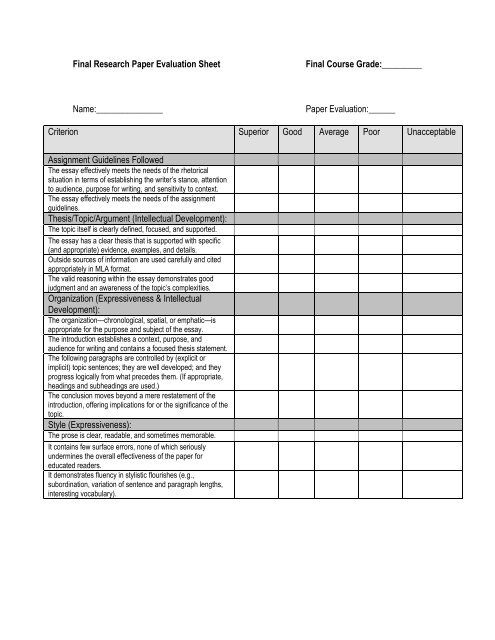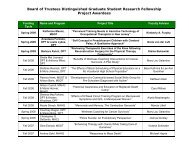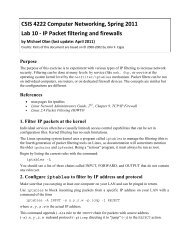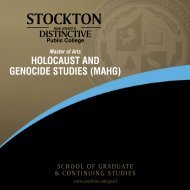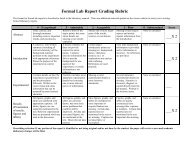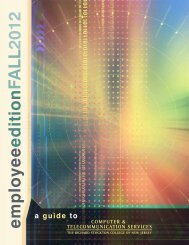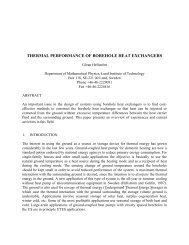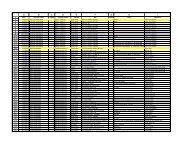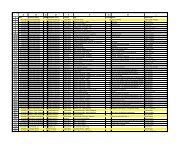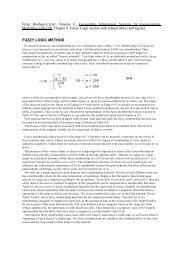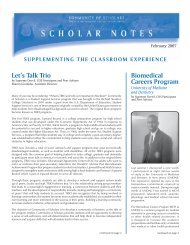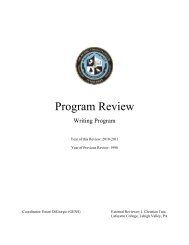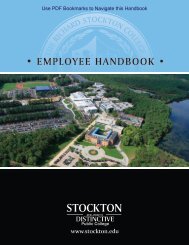Final Research Paper Evaluation Sheet Final Course Grade
Final Research Paper Evaluation Sheet Final Course Grade
Final Research Paper Evaluation Sheet Final Course Grade
You also want an ePaper? Increase the reach of your titles
YUMPU automatically turns print PDFs into web optimized ePapers that Google loves.
<strong>Final</strong> <strong>Research</strong> <strong>Paper</strong> <strong>Evaluation</strong> <strong>Sheet</strong><br />
<strong>Final</strong> <strong>Course</strong> <strong>Grade</strong>:_________<br />
Name:_______________<br />
<strong>Paper</strong> <strong>Evaluation</strong>:______<br />
Criterion Superior Good Average Poor Unacceptable<br />
Assignment Guidelines Followed<br />
The essay effectively meets the needs of the rhetorical<br />
situation in terms of establishing the writer’s stance, attention<br />
to audience, purpose for writing, and sensitivity to context.<br />
The essay effectively meets the needs of the assignment<br />
guidelines.<br />
Thesis/Topic/Argument (Intellectual Development):<br />
The topic itself is clearly defined, focused, and supported.<br />
The essay has a clear thesis that is supported with specific<br />
(and appropriate) evidence, examples, and details.<br />
Outside sources of information are used carefully and cited<br />
appropriately in MLA format.<br />
The valid reasoning within the essay demonstrates good<br />
judgment and an awareness of the topic’s complexities.<br />
Organization (Expressiveness & Intellectual<br />
Development):<br />
The organization—chronological, spatial, or emphatic—is<br />
appropriate for the purpose and subject of the essay.<br />
The introduction establishes a context, purpose, and<br />
audience for writing and contains a focused thesis statement.<br />
The following paragraphs are controlled by (explicit or<br />
implicit) topic sentences; they are well developed; and they<br />
progress logically from what precedes them. (If appropriate,<br />
headings and subheadings are used.)<br />
The conclusion moves beyond a mere restatement of the<br />
introduction, offering implications for or the significance of the<br />
topic.<br />
Style (Expressiveness):<br />
The prose is clear, readable, and sometimes memorable.<br />
It contains few surface errors, none of which seriously<br />
undermines the overall effectiveness of the paper for<br />
educated readers.<br />
It demonstrates fluency in stylistic flourishes (e.g.,<br />
subordination, variation of sentence and paragraph lengths,<br />
interesting vocabulary).
<strong>Final</strong> <strong>Research</strong> <strong>Paper</strong> Rubric—Detailed Explanation<br />
Assignment Guidelines Followed:<br />
A (SUPERIOR)<br />
_____Demonstrates a familiarity with literary terms and theories in general and of the literary<br />
criticism of the primary text being analyzed and incorporates them smoothly into an<br />
argument<br />
_____The writer’s rhetorical stance is clearly articulated<br />
_____Page guidelines met or exceeded without fluff or margin and font play; every word needed.<br />
B (GOOD)<br />
_____Shows a familiarity with literary terms and theories as well as related critical text, and<br />
incorporates them into an argument<br />
_____The writer’s rhetorical stance is clearly stated or implied<br />
_____Page guidelines met or exceeded without fluff or margin and font play.<br />
C (AVERAGE)<br />
_____Demonstrates some familiarity with literary terms and theories as well as related critical<br />
text, but does not incorporate them clearly<br />
_____The writer’s rhetorical stance is implied but not clearly stated<br />
_____Page guidelines met or exceeded without margin and font play, but some material may not<br />
be incorporated well.<br />
D (POOR)<br />
_____The paper displays little familiarity with literary terms, theories, or criticism<br />
_____No rhetorical stance is articulated<br />
_____Page guidelines nearly met, but material may not be incorporated well.<br />
F (UNACCEPTABLE)<br />
_____The paper displays no familiarity with literary terms, theories, or criticism<br />
_____No rhetorical stance is apparent<br />
_____Page guidelines not met.<br />
Thesis/Topic/Argument (Intellectual Development):<br />
A (SUPERIOR)<br />
_____Insightful, cogent response to a literary text and the questions that the text raises<br />
_____Reasoning is persuasive and supported by detailed, relevant examples<br />
_____The central point or thesis is focused for a specific audience, clearly defined, and gracefully<br />
stated<br />
_____<strong>Research</strong> is thorough, well documented, and effectively integrated into the text. Perfect<br />
MLA documentation
B (GOOD)<br />
_____Provides a thoughtful, well-developed response to a literary text and the questions the text<br />
raises<br />
_____Reasoning is sensible and supported by appropriate examples<br />
_____The central idea or thesis is focused and clearly defined<br />
_____There is clear evidence of research, but it not always appropriately used or effectively<br />
integrated into the text. Near perfect MLA citation<br />
C (AVERAGE)<br />
_____Presents a clear response to a literary text and the questions the text raises<br />
_____<strong>Paper</strong> is developed with acceptable reasoning and adequate examples, but these examples<br />
are sometime sketchy, vague, or repetitious<br />
_____The central point or thesis is apparent but not clearly stated<br />
_____There is evidence of research, but it is not always appropriately used or effectively<br />
integrated into the text. Good MLA citation<br />
D (POOR)<br />
_____Responds to a literary text in an illogical and/or incomplete way<br />
_____While some good examples are provided, for the most part the essay is underdeveloped<br />
_____The central point or thesis is confusing, sometimes contradictory, and/or not explicitly<br />
stated<br />
_____There is little evidence of research, and that is poorly documented and ineffectively used to<br />
develop the paper. Poor MLA citation<br />
F (UNACCEPTABLE)<br />
_____Presents a simplistic, inappropriate and/or incoherent response to a literary text<br />
_____Examples are lacking or misused<br />
_____The central point is not apparent<br />
_____No research is evident. Unacceptable MLA citation<br />
Organization (Expressiveness & Intellectual Development):<br />
A (SUPERIOR)<br />
_____Organization strategies (e.g., chronological, spatial, or emphatic; topic headings) are<br />
appropriate to the topic and consistently controlled<br />
_____Paragraph breaks correspond to shifts in topic; paragraph topics are focused and clearly<br />
articulated; transitions are smooth and logical<br />
B (GOOD)<br />
_____Organizational strategies (e.g., chronological, spatial, or emphatic; topic headings) are<br />
appropriate to the topic and usually controlled<br />
_____Paragraph breaks correspond to shifts in topic; the paragraph topics are usually focused;<br />
and transitions are attempted although they are sometimes weak or ineffective
C (AVERAGE)<br />
_____Organizational strategies (e.g., chronological, spatial, or emphatic; topic headings) are<br />
usually controlled<br />
_____Paragraph breaks usually correspond to shifts in topic; the paragraph topics are usually<br />
focused; some transitions are attempted but are weak or ineffective<br />
D (POOR)<br />
_____Organizational strategies (e.g., chronological, spatial, or emphatic; topic headings) are only<br />
partially in control and applied inconsistently<br />
_____Paragraph breaks are arbitrary and paragraph topic are not always apparent; transitions are<br />
choppy<br />
F (UNACCEPTABLE)<br />
_____Organizational strategies are not apparent<br />
_____Paragraph breaks are arbitrary and paragraph topic are not always apparent; transitions are<br />
lacking.<br />
Style (Expressiveness):<br />
A (SUPERIOR)<br />
_____Original imagery may be used to convey thoughts and emotions<br />
_____Ideas are expressed clearly and directly; sentences are varied and consistently wellconstructed<br />
_____<strong>Final</strong> draft is close to error-free<br />
B (GOOD)<br />
_____No original imagery is used, or imagery may be ineffective<br />
_____Ideas are usually expressed clearly, but prose is characterized by a lack of directness and/or<br />
conciseness; occasionally imprecise word choice; little sentence variety; and occasional<br />
major and minor errors in grammar occur<br />
_____<strong>Final</strong> draft has one section that may contain several errors but the majority of the paper is<br />
close to error-free<br />
C (AVERAGE)<br />
_____Imagery lacks effectiveness<br />
_____Ideas are usually expressed clearly but the prose is characterized by a lack of directness<br />
and/or lack of conciseness; frequently imprecise work choice; little sentence variety;<br />
occasional major errors in grammar and frequent minor errors<br />
_____Several sections of the final draft require final editing for errors<br />
D (POOR)<br />
_____Imagery is generally lacking and/or inappropriately used<br />
_____The paper relies on summary rather than analysis<br />
_____Most the final draft require final editing for errors<br />
F (UNACCEPTABLE)<br />
_____Imagery is generally lacking and/or inappropriately used<br />
_____The paper relies on summary rather than analysis<br />
_____The paper is riddled with errors


